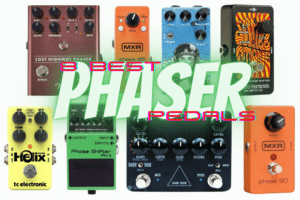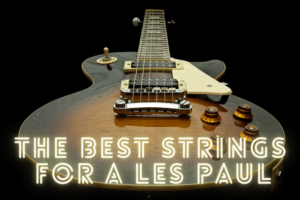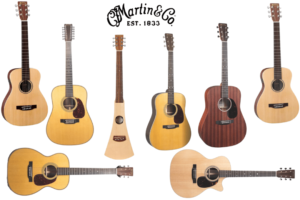Here’s our review of the 6 Best Vibrato Pedals.
Vibrato pedals are popular guitar effect pedal that adds a subtle or pronounced pulsating modulation to a guitar or other instrument’s sound.
The best vibrato pedals can enhance the expressiveness and musicality of a player’s performance, adding depth and character to your tone.
With a wide variety of vibrato pedals available on the market, each with its unique features and characteristics, it can be challenging for musicians to choose the right one for their needs.
This is where our comprehensive review of the best vibrato pedals can be useful.
This review explores some of the top vibrato pedals available, highlighting their key features, strengths, and weaknesses. We’ll also consider factors such as build quality, sound quality, versatility, and ease of use, to help musicians make an informed decision when selecting a vibrato pedal.
Whether you’re a beginner or a seasoned pro, this review will provide valuable insights to help you choose the best vibrato pedal for your style and musical goals.
Quick View: The 6 Best Vibrato Pedals

The Boss VB-2W Waza Craft Vibrato Pedal is a high-quality effects pedal known for its authentic and versatile vibrato effect. It offers vintage and modern sounds, an expression pedal input for real-time control, and a “Rise Time” control for custom vibrato.


2–Kokko Acoustic Guitar Effect
The Kokko Acoustic Guitar Effects pedal provides a broad selection of effects, including reverb, delay, chorus, compression, EQ, and more. Guitarists can explore diverse sonic possibilities, from subtle enhancements to creative experimentation, making it a versatile tool for acoustic musicians.


The Behringer Ultra Vibrato UV300 Classic pedal offers a wide range of effects including vintage style vibrato and chorus tones. It is ideal for guitarists seeking versatile modulation effects to add depth and character to their sound


The MXR M68 Uni-Vibe Chorus/Vibrato pedal offers a broad spectrum of modulation effects, spanning from rich chorus textures to mesmerizing vibrato. It caters to guitarists in search of dynamic modulation to craft atmospheric tones and evoke classic psychedelic sounds..


The TC Electronic TAILSPIN is a go-to choice for guitarists seeking to infuse their sound with dynamic modulation, offering a plethora of effects like vintage tremolo and auto-swell that enhance expressiveness and musicality.


The Sonicake Chorus Vibrato Flanger pedal boasts a versatile range of effects, including rich chorus, swirling vibrato, and dynamic flanger. It suits guitarists who crave sonic experimentation and desire to add depth and texture to their playing.

My Choice: The Ultimate Vibrato Pedal for Professional Guitarists
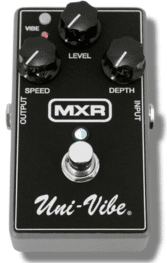
If you’re on the hunt for a Uni-Vibe pedal that delivers exceptional value without compromising on quality, look no further than the MXR M68.
This pedal truly stands out in its field by offering top-notch modulation effects that capture the essence of vintage psychedelic tones. Not only does it faithfully replicate those classic sounds, but it also does so at a reasonable price, giving you the best bang for your buck.
With its solid build quality and authentic tonal reproduction, the MXR M68 Uni-Vibe pedal is a standout choice that guarantees a satisfying modulation experience without breaking the bank.
In my opinion the MXR Uni-Vibe pedal elevates my playing with added depth, warmth, and an undeniable vintage essence. Other pedals around this price tag cannot compete.
You’re always guaranteed a good sturdy performer with MXR, making it less of a gamble when parting ways with your hard earned dollar.
Best Budget: The Budget-Friendly Vibrato Pedal that Delivers Great Sound

The SONICAKE 5th Dimension Modulation Pedal wins my vote for the Best Budget Vibrato pedal.
The Sonicake introduces you to a realm of sonic enchantment with its remarkable 11-Mode Digital Modulation specs.
Considering the low cost, this benefit in itself is just fantastic. This innovation encapsulates a diverse array of modulation effects, each meticulously crafted to elevate your sound.
From the dreamy allure of chorus to the hypnotic sweeps of flanger, the vintage warmth of phaser, the rhythmic pulsations of tremolo, the expressive touch of vibrato, and the dynamic engagement of autowah, these 11 modes offer a comprehensive toolkit to shape your sonic landscape.
The digital precision of these modes ensures consistency and accuracy, while the intuitive controls put you in the driver’s seat, enabling effortless customization.
Delve into the world of modulation mastery with the SONICAKE 5th Dimension, where every mode becomes a gateway to limitless sonic exploration.
…..
Importance of vibrato pedals in guitar playing
Vibrato pedals can add texture, depth, and emotion to guitar playing by manipulating the pitch of individual notes or chords.
They can be adjusted in speed, depth, and intensity to create a range of effects from subtle and smooth to dramatic and intense.
Furthermore, vibrato pedals offer guitarists a versatile tool to shape their musical expression across various genres and playing styles.
In blues and jazz, a slow and controlled vibrato can infuse notes with a languid, soulful quality, allowing players to pour their emotions into every phrase. On the other hand, in rock and metal, a faster and more pronounced vibrato can inject energy and urgency into riffs and solos, driving the music forward with an electrifying intensity.
This adaptability makes vibrato pedals essential for a guitarist’s sonic palette, empowering them to craft captivating performances that resonate deeply with listeners and elevate the overall musical experience.
A brief history of vibrato pedals and their evolution
Vibrato tone pedals have been essential for guitarists since the 1960s when Fender introduced the first vibrato effect in their amplifiers. The effect varies pitch, creating a wobbling sound.
The DeArmond vibrato pedals were bulky and had one knob to control intensity, followed by models from Electro-Harmonix and Boss.
While chorus effects were developed in the 1970s, many guitarists preferred the characterful vibrato effect.
Digital technology in the 1980s enabled advanced pedals that could produce a wider range of sounds like chorus and flanger effects.
In the 1990s, boutique makers created vintage replicas with high-quality components and unique features.
Today, there are various vibrato pedals, from simple analog to complex digital effects, and the best one depends on individual preferences and playing style.
Full Review: Top 6 Best Vibrato Pedals to Elevate Your Guitar Sound
1- Boss VB-2W Waza Craft Vibrato Pedal
Best for Vintage Sounds

The Boss VB-2W Waza Craft Vibrato Pedal is a high-quality effects pedal designed for guitarists looking for an authentic and versatile vibrato effect.
This pedal is part of the Waza Craft series, known for its exceptional sound quality and attention to detail.
One of the standout features of the VB-2W is its ability to produce both vintage and modern vibrato sounds.
The pedal includes two modes: Standard mode faithfully replicates the original VB-2 pedal. In contrast, the Custom mode offers a wider range of vibrato sounds, including more intense modulation for your guitar tone.
Another notable feature of the VB-2W is its expression pedal input, which allows for real-time control of the vibrato effect.
This can be particularly useful for guitarists who want to add subtle or dramatic vibrato effects to their playing, depending on the dynamics of the music.
The VB-2W also includes a “Rise Time” control, which adjusts the speed at which the vibrato effect kicks in. This can be useful for creating custom vibrato sounds that compliment different playing styles and musical genres.
Overall, the Boss VB-2W Waza Craft Vibrato Pedal is a high-quality and versatile effects pedal ideal for guitarists who want to add an authentic vibrato pedal to their arsenal.
Its range of features and attention to detail make it a top choice for professional musicians and hobbyists alike.
Pros
Authentic vintage vibrato tones with modern craftsmanship
Versatile control over speed, depth, and rise time
Waza Craft quality ensures durability and premium sound
Cons
Limited to vibrato effect only, lacks additional modulation options
2- Kokko Acoustic Guitar Effect Pedal (FVB2)
Best for Acoustic Guitar

The Kokko Acoustic Guitar Effect Pedal (FVB2) is a compact and affordable pedal designed specifically for acoustic guitar players looking to enhance their sound. Here are some of its features and benefits:
Volume Control: The pedal has a volume control knob that allows you to adjust the overall volume of your acoustic guitar, making it easier to balance with other instruments in a live or recording setting.
Feedback Control: One of the biggest challenges for acoustic guitar players is controlling feedback when playing at high volumes.
The FVB2 has a feedback control knob that helps to minimize unwanted feedback, allowing you to play at higher volumes without worrying about disrupting performance.
Tone Control: The pedal has a tone control knob that allows you to adjust the overall tone of your guitar, allowing you to shape your sound to your liking. This feature is particularly useful for players who want to create a more customized sound.
LED Indicator: The FVB2 has an LED indicator that lets you know when the pedal is engaged, so you can easily see if the effect is on or off.
True Bypass Switch: The pedal has a true bypass mode, which means that when it is turned off, it does not affect the sound of your guitar at all. This is particularly useful for players who want to maintain the natural sound of their guitar without any added effects.
The Kokko Acoustic Guitar Effect Pedal (FVB2) is a great option for acoustic guitar players who want to enhance their sound without breaking the bank.
Its volume, feedback, tone controls, LED indicator, and true bypass function offer a range of features that will benefit any player looking to improve their sound.
Pros
Simple and intuitive controls for easy use
Low noise operation for clean and clear vibrato effect
Durable construction ensures reliability for long-term use
Cons
Limited tonal options compared to higher-end vibrato pedals
3- Behringer Ultra Vibrato UV300 Classic Vibrato Instrument Effects Pedal
Affordable option from a big brand
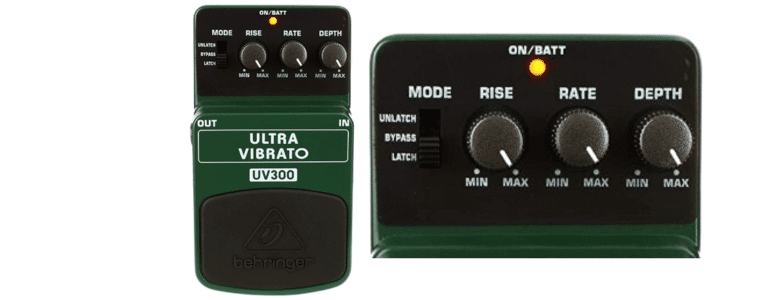
The Behringer Ultra Vibrato UV300 is a classic vibrato effects pedal designed for guitarists and other instrumentalists who want to add a rich, modulated sound to their performances. Here are some of its key features and benefits:
Vibrato effect: The main feature of the UV300 is its vibrato effect, which creates a slight pitch variation in the signal to add a sense of motion and depth to the sound. This effect can be adjusted using the Rate and Depth controls, allowing you to achieve a wide range of vibrato sounds from subtle to intense.
Classic design: The UV300 is designed to emulate the classic vibrato effects pedals of the 1960s and 1970s, giving your sound a vintage feel reminiscent of classic rock and roll and surf music.
The pedal’s rugged metal casing and true bypass switching make it durable and easy to use on stage.
Versatile sound shaping: Besides the basic vibrato effect, the UV300 also includes a Tone control that allows you to shape the overall tonality of the signal. This can be especially useful for dialing in just the right amount of warmth or brightness to complement your playing style and the natural tone of your instrument.
Affordable price: Perhaps the biggest benefit of the UV300 is its affordable price point, which makes it accessible to a wide range of players on a budget.
Despite its low cost, the pedal delivers a high-quality sound and reliable performance that’s sure to impress.
Overall, the Behringer Ultra Vibrato UV300 is an excellent choice for guitarists and other instrumentalists who want to add a classic vibrato effect to their sound.
With its vintage-inspired design, versatile sound shaping capabilities, and affordable price, this pedal will surely become a staple of your effects rig.
Pros
Affordable option with a superb wide range of vibrato sounds
Easy-to-use controls for adjusting speed, depth, and tone
Versatile input/output options for seamless integration into different setups
Cons
Possible issues with durability and longevity compared to higher-end pedals
4- MXR M68 Uni-Vibe Chorus/Vibrato
Authentic Tones and Mega Seller

The MXR M68 Uni-Vibe Chorus/Vibrato is a guitar effects pedal that aims to replicate the classic sound of the Uni-Vibe pedal originally made famous by Jimi Hendrix in the 1960s.
One of the key features of the MXR M68 is its dual-mode operation, which allows the user to switch between chorus and vibrato effects.
This gives guitarists the flexibility to use the pedal in a variety of musical contexts and to achieve a range of tonal textures.
Another benefit of the MXR M68 is its compact and durable design, which makes it ideal for use on stage or in the studio.
The pedal is housed in a rugged metal enclosure that is built to withstand the rigors of regular use, and its compact size means that it won’t take up too much valuable real estate on a crowded pedalboard.
Additionally, the MXR M68 features true bypass switching, which helps to maintain the integrity of the guitar’s signal when the pedal is not in use. This means that the guitar’s tone remains unaffected by the pedal when bypassing it, ensuring its original sound is preserved.
Overall, the MXR M68 Uni-Vibe Chorus/Vibrato is a versatile and reliable pedal well-suited to various musical styles and playing situations.
Its dual-mode operation, compact design, and true bypass switching make it a great choice for guitarists looking for a high-quality Uni-Vibe effect in a compact and reliable package.
Pros
Authentic replication of classic Uni-Vibe chorus and vibrato tones
Intuitive controls for precise adjustments of speed, intensity, and volume
Built with high-quality components for superior sound and durability
Cons
Relatively higher price compared to entry-level vibrato pedals
5- TC Electronic TAILSPIN VIBRATO

The TC Electronic TAILSPIN VIBRATO is a guitar effects pedal designed to add a classic vibrato effect to your guitar sound. Some of its key features include:
True bypass switch: This feature ensures that the pedal does not affect the signal when not in use, ensuring a clean and uncolored tone.
Rate Control: Adjusts the frequency at which the pitch modulation cycles, determining the speed of the vibrato effect. Allows a guitarist to tailor the speed of the pitch modulation effect to match their playing style and musical context, adding depth and character to their sound.
Depth Controls: Controls the intensity or amount of pitch modulation applied to the guitar signal.
By adjusting the ‘Depth’ knob, a guitarist can customize the level of pitch modulation effect, allowing them to create subtle or pronounced vibrato tones to enhance their playing and musical expression.
Compact size: The Tailspin Vibrato is small and lightweight, making it easy to fit into the traffic of your already busy pedal board.
The benefit of the Tailspin is that it provides a classic vibrato effect that can add depth and dimension to your ax playing.
Adjusting the effect’s speed, depth, and ramp allows you to create a wide range of sounds, from subtle vibrato to more intense and dramatic effects.
The true bypass ensures your tone remains pure when the pedal is unused. At the same time, the compact size makes it a convenient and portable addition to your pedalboard.
Pros
Affordable option without compromising on quality
Easy and intuitive operation for quick dialing of vibrato sounds
Wide range of adjustable parameters for customizing the vibrato effect
Cons
Limited control options compared to more feature-rich vibrato pedals.
6- Sonicake Chorus Vibrato Flanger Guitar Effects Pedal

The Sonicake Chorus Vibrato Flanger, Guitar Effects Pedal, is a multi-effect pedal for guitar players. Here are some of its features and benefits:
Three Effects in One: The Sonicake Chorus Vibrato Flanger combines three popular guitar effects into one compact pedal. This means you don’t need to purchase three separate pedals, saving space on your pedalboard and money in your wallet.
Wide Range of Sound: You can achieve a wide range of sounds, from subtle modulation to more extreme effects. This allows you to experiment with different sounds and find the perfect tone for your playing style.
True Bypass Switch: The pedal features true bypass switching, which means it won’t affect your guitar’s signal when the pedal is turned off. This ensures that your guitar’s tone remains pure and unaffected.
Easy to Use: With simplistic controls that allow you to dial in your desired sound quickly and easily. This makes it ideal for both beginners and more experienced guitar players. No faff!
Compact Design: The pedal is compact and won’t take up too much space on your pedalboard. This is great if you have a mountain of pedals and limited space.
Durable Construction: Its built to last, with a sturdy metal construction that can withstand the rigors of gigging and touring.
Overall, the Sonicake Chorus Vibrato Flanger Guitar Effects Pedal is a versatile and affordable multi-effect pedal combining three popular effects.
Pros
Affordable option with a good balance between features and price
Wide range of adjustable parameters for fine-tuning the desired effect
Amazing user ratings and feedback
Cons
Possible limitations in terms of sound quality and durability compared to higher-end pedals
Choosing the Right Vibrato Pedal (Buying Guide)

Vibrato Pedals Explained
A vibrato pedal can benefit a guitarist by adding a dynamic and expressive quality to their playing, creating a sense of movement and depth in their sound that can enhance solos, chord progressions, songwriting, and other musical passages.
Additionally, the ability to adjust the rate and depth of the effect allows guitarists to fine-tune the vibrato to their individual preferences, making it a versatile tool for crafting unique and personalized sounds.
Common Controls on Vibrato Pedals
Vibrato pedals typically feature two main controls: the Rate and Depth knobs.
The Rate control adjusts the speed of the vibrato effect, ranging from a slow, subtle modulation to a fast and pronounced warble.
The Depth control adjusts the intensity of the effect, determining how much the signal’s pitch is modulated.
Some vibrato pedals may also include additional controls such as a Tone knob, which adjusts the overall tonality of the signal, or a waveform selector, which allows users to choose between different types of vibrato waveforms such as sine, triangle, or square.
It’s important to note that the specific controls and their functions may vary between different vibrato pedals. Hence, it’s always a good idea to consult the pedal’s user manual or online resources to fully understand how to use its controls to achieve the desired sound.

How Vibrato Pedals in the Recording Studio can benefit you:
Vibrato pedals can benefit guitarists in the recording studio by adding a unique and expressive quality to their playing that can enhance the overall sound of a recording.
Vibrato can add movement and depth to guitar parts, making them stand out in a mix and creating a more dynamic and engaging listening experience.
Additionally, the ability to adjust the rate and depth of the vibrato effect allows guitarists to fine-tune the effect to fit the specific needs of a recording, whether it’s a subtle modulation to add warmth to a rhythm part or an intense warble to create an otherworldly solo tone.
Using a vibrato pedal in the recording studio also allows guitarists to experiment with vibrato effects, such as sine, triangle, or square waveforms, to find the perfect sound for their recording.
Incorporating a vibrato pedal into a recording setup can open up many creative possibilities for guitarists and help them achieve more polished and professional recordings.

Buffered vs. True Bypass Vibrato Pedals: Pros and Cons
Buffered and true bypass are circuit designs commonly found in vibrato pedals, each with its own pros and cons.
Buffered pedals keep the signal flowing through the pedal’s circuit, even when the effect is turned off. This can help maintain the quality of the signal, prevent tone loss or degradation, and eliminate any potential pops or clicks when the effect is engaged or disengaged.
However, some players may prefer a true bypass switch design to maintain the purity of their signal and avoid any coloration or alteration of their tone.
True bypass pedals, on the other hand, completely disconnect the pedal’s circuit from the signal chain when the effect is turned off.
This can help preserve the guitar’s natural tone and prevent any unwanted noise or interference from the pedal’s circuitry.
However, true bypass pedals can sometimes cause tone loss or signal degradation when used with long cables or multiple effects in a pedal chain.
Choosing between a buffered or true bypass vibrato pedal depends on the player’s preferences and needs.
If signal clarity and purity are paramount, a true bypass pedal may be the preferred choice. I know it is for me! However, if maintaining a consistent and high-quality signal is more important, a buffered pedal may be the way to go.
It’s always a good idea to test out both pedals and listen carefully to how they affect your sound before making a final decision.
Vibrato Pedals in the Effects Loop: How to Use Them Effectively
Vibrato pedals can be used effectively in an amplifier’s effects loop or other effects devices to achieve many tonal possibilities.
When using a vibrato pedal in the effects loop, it’s important to consider the order of effects in the chain to achieve the desired sound.
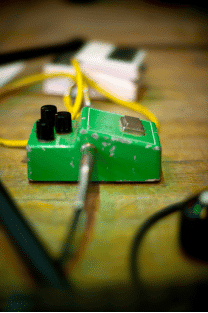
Placing the vibrato pedal after distortion or overdrive effects can create a more intense and pronounced vibrato effect. Placing it before any modulation or time-based effects such as delay or reverb can create a more subtle and blended vibrato.
Additionally, using the effects loop allows players to control the volume of the vibrato effect separately from the main signal, giving them more flexibility to adjust the overall balance of their tone.
It’s important to note that not all amplifiers or effects devices have an effects loop, so it’s important to check the specifications of your gear before attempting to use a vibrato pedal in this way.
Additionally, experimenting with different placement and settings of the vibrato pedal can help players find the perfect sound to fit their playing style and desired tone.
Dual Output Vibrato Pedals: What Are They and When to Use Them
Dual output vibrato pedals have two separate outputs, allowing players to send their dry and affected signals to different destinations.
One common use for dual output vibrato pedals is to send the dry signal to one amplifier or mixer while sending the affected signal to a different amplifier or mixer. This allows players to blend the two signals to create a unique and complex sound or to isolate and manipulate each signal separately to achieve specific tonal qualities.
Another use for dual output vibrato pedals is to send the affected signal to a second effects device, such as a delay or reverb pedal, to shape further and enhance the vibrato effect. This can create a more immersive and atmospheric sound that can add depth and dimension.
Overall, dual output vibrato pedals are a versatile tool that can offer players a range of creative possibilities.
Whether used to blend signals, create complex soundscapes, or shape the tonal qualities of the vibrato effect, a dual output vibrato pedal can be a valuable addition to any guitarist’s pedalboard.
Features to Consider While Choosing Vibrato Pedal
Sound quality: Analog or Digital
When choosing a vibrato pedal, there are several key features to consider, including:
- Sound quality: Do you prefer the warmth and character of an analog signal or the precision and versatility of a digital signal?
- Controls: Look for pedals that offer intuitive and easy-to-use controls that allow you to shape and customize your vibrato effect to fit your playing style.
- Power options: Consider whether you want a pedal that runs on batteries or requires an external power source and whether you need additional power options such as daisy chaining.
- Size and durability: Look for compact and durable pedals to withstand regular use and transport.
- Price: Determine how much you’re willing to spend and look for the best possible benefits for the lowest price.
- Brand reputation: Consider the brand’s reputation and read reviews from real players to understand the pedal’s reliability and quality.
- True bypass vs. buffered: Decide whether you want a pedal with true bypass or buffered circuitry based on your personal preference and the needs of your signal chain.
In terms of Analog vs. Digital sound quality, here are some key points to consider:

Analog:
- Typically has a warmer and more organic sound.
- Can provide a natural and vintage-style vibrato effect.
- May have more limited controls and settings.
- Can sometimes add noise or interference to the signal chain.
Digital:
- Can provide a more precise and versatile vibrato effect.
- May offer a wider range of controls and settings.
- Can sometimes sound more sterile or artificial compared to analog.
- May require additional power options or equipment to achieve the desired sound.

Additional effects: Chorus, Flanger, Tremolo.
When choosing a vibrato pedal, it’s important to consider whether you want additional effects such as chorus, flanger, or tremolo. Here are some key points to keep in mind:
Chorus Effect:
- Offers a similar modulation effect to vibrato but typically with a more subtle and blended sound.
- Can add depth and dimension to your tone and create a sense of movement.
- May have additional controls such as rate, depth, and mix for further customization.
Flanger:
- Offers a more intense modulation effect that can create a sweeping and jet-like sound.
- Can be used to create unique textures and soundscapes.
- Additional controls, such as feedback and resonance, may be needed for further customization.
Tremolo:
- Offers a rhythmic modulation effect that can create a pulsing or chopping sound.
- Can be used to add movement and intensity to your playing.
- Additional controls, such as speed and depth, may be needed for further customization.
Overall, choosing a vibrato pedal with additional effects can offer a wider range of tonal possibilities and creative options.
However, it’s important to consider whether you really need these additional effects and whether they fit your playing style and musical preferences.
Additionally, pedals with multiple effects can sometimes be more complex and difficult to use, so make sure you’re comfortable with the controls and settings before purchasing.
Circuit type: Optical or Analog.
Another important feature to consider when choosing a vibrato pedal is the circuit type, which can be either optical or analog. Here are some key points to keep in mind:
Optical:
- It uses an LED and light-sensitive resistor to create the vibrato effect.
- Offers a smooth and natural-sounding vibrato.
- Generally more reliable and consistent compared to analog.
- Can be less prone to noise or interference.
Analog:
- It uses an electronic circuit to create the vibrato effect.
- Offers a warmer and more organic sound compared to optical.
- May have more character and personality.
- Can sometimes add noise or interference to the signal chain.
Choosing between optical and analog circuitry is a matter of personal preference and the type of sound you’re going for.
Optical may be the way to go if you want a more natural and consistent vibrato effect.
If you prefer a warmer and more characterful sound, analog may be the better choice.
Additionally, consider factors such as reliability, noise, and interference when deciding.
Dimensions and Portability.
When choosing a vibrato pedal, it’s also important to consider its dimensions and portability, especially if you plan to use it for gigs or rehearsals. Here are some key points to keep in mind:
Dimensions:
- Check the pedal’s size and weight to ensure it fits comfortably on your pedalboard and doesn’t take up too much space.
- Some pedals are designed to be more compact and space-saving, while others may have more controls and features but be larger and bulkier.
Portability:
- Consider how easy it is to transport the pedal to gigs or rehearsals.
- Some pedals may come with a carrying case or bag, while others require additional protection or storage solutions.
- Look for durable pedals built to withstand travel and frequent use.
Overall, the dimensions and portability of a vibrato pedal are important factors to consider if you plan to use it for performances or travel.
Make sure the pedal fits comfortably on your pedalboard and is easy to transport, durable, and built to last. Lat thing you want is a pedal to break mid-song.

Budget vs. Premium
When choosing a vibrato pedal, price is an important consideration, as options are available at various price points.
Here are some key points to keep in mind:
Budget:
- Budget vibrato pedals can be a good choice if you’re just starting out or are on a tight budget.
- They may offer fewer features or a simpler design but can still deliver a decent vibrato effect.
- Look for pedals from reputable brands with positive reviews from real guitar-playing buyers to ensure quality and reliability.
Premium:
- Premium vibrato pedals are typically more expensive but may offer more features, better sound quality, and higher build quality.
- They may also come from boutique brands with unique designs and limited production runs.
- Consider whether the additional features and quality are worth the extra cost for your needs and playing style.
Overall, the price of a vibrato pedal should be considered alongside its features, sound quality, and build quality.
Budget pedals can be a good starting point but may have limitations. In contrast, premium pedals may offer more options and better performance but at a higher cost.
Ultimately, choose the best vibrato pedal for your needs and budget while considering reliability, durability, and sound quality.
FAQs
A. What is the difference between vibrato and tremolo effects?
Vibrato changes the guitar signal’s pitch cyclically, creating a sense of vibrancy and a wobbling effect. In contrast, tremolo changes the guitar signal’s volume cyclically, creating variations in the intensity of the sound wave. While these effects have a similar cyclic modulation characteristic, their impact on the sound produced is quite different, and they can be used to achieve different soundscapes and moods.
B. Why is an analog circuit preferred over a digital circuit?
Analog circuits precisely represent physical changes like sound, light, temperature, and pressure, making them preferable in some applications. In contrast, digital circuits are more reliable and accurate, though less tolerant of electrical issues, with the choice between them depending on the specific application and needs.
C. How does bypass in pedal circuits work?
Pedal bypass refers to the ability to directly route the guitar signal to the amplifier without interference or loading effects caused by pedals. True bypass is a circuitry type that removes the whole effect circuit from the signal path when the pedal is turned off, maintaining the guitar’s tone and signal. True-bypass results in a cleaner and more transparent sound, benefiting us guitarists.
D. Can a vibrato pedal be used with other pedals?
Yes, a vibrato pedal can be combined with other pedals to create unique sounds, as it is an effects unit that detunes the guitar signal based on different parameters like intensity and speed. Many guitar players use multiple pedals to achieve their desired sound.


